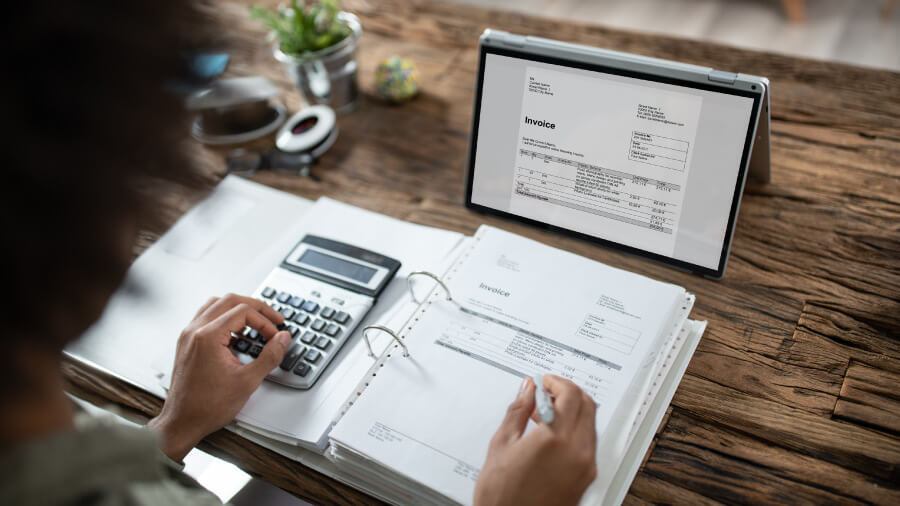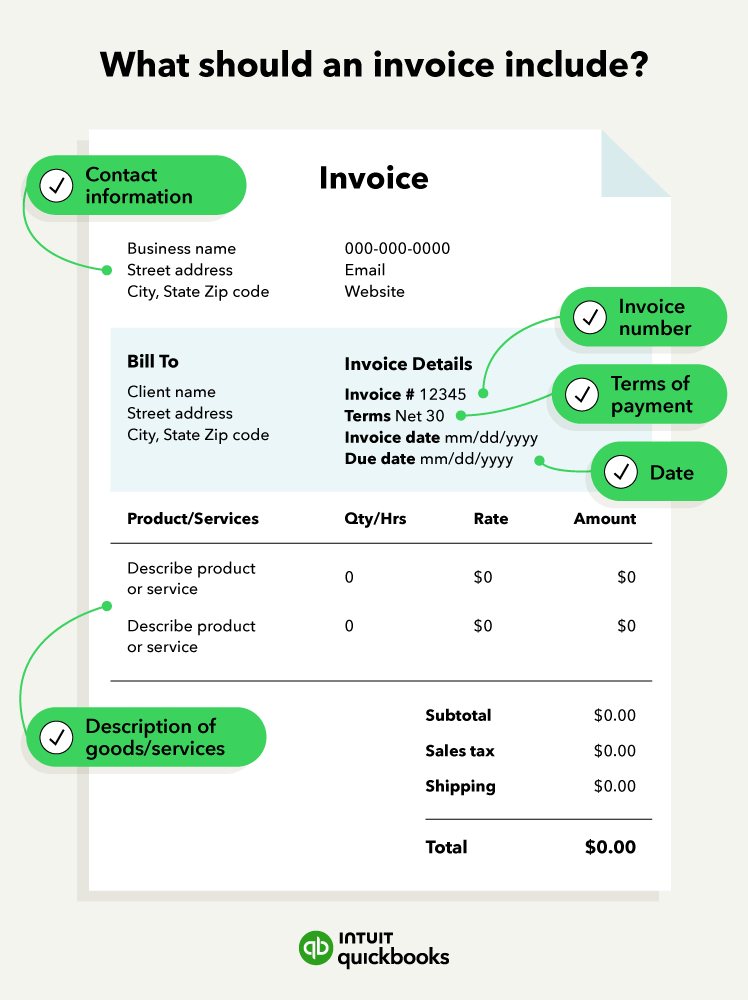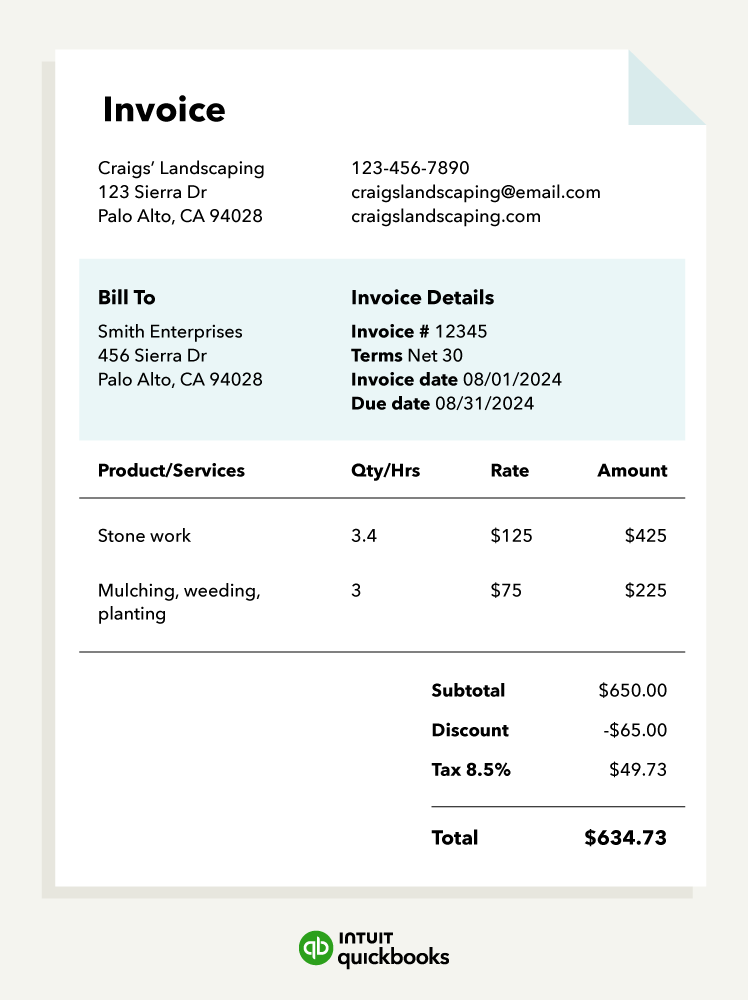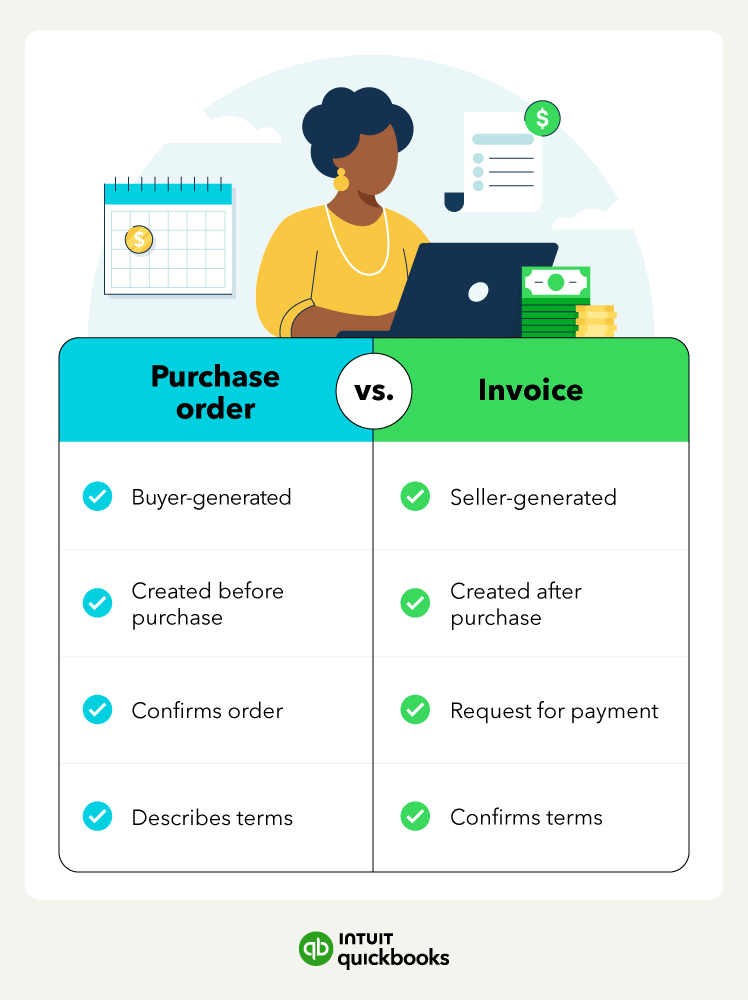
What is an invoice? Definition and examples [free templates]
By Marshall Hargrave
June 20, 2024
Invoice definition
An invoice is a formal document that itemizes and records a transaction between a vendor and a buyer. Businesses use invoices to ensure they receive timely payments in full.
Businesses send invoices to clients after they deliver a product or service. The invoice tells the buyer how much they owe the seller and establishes payment terms for the transaction.
Creating invoices with clear payment terms can save your business time and money. Learn what invoices are, why businesses use them, and the elements you need to create one in this guide. We’ll also provide examples, templates, and an invoice generator to help you streamline your invoicing process.
What is an invoice?
The definition of an invoice is simply a document listing goods or services and the total amount expected as payment for delivery of these items. For most business owners, invoices are formal documents outlining specific transaction details to ensure they receive proper compensation.
Businesses use invoices to monitor cash flow and help ensure they receive payment in full and on time. Invoices also serve as records of sales, providing a way to track:
- The sell date of a good or service
- How much is the business charged for the good or service
- Any outstanding balances the client owes
Additionally, invoices can help you protect your company in the event of an audit, as they help to create a paper trail. Detailed invoices will show the IRS exactly where your money came from should they question your tax returns.
When selling products or services, enter the invoice amount as accounts payable on the buyer’s end. For a business, the invoice is in accounts receivable.
How invoices differ from bills and receipts?
Both invoices and bills are records of a sale that indicate how much a customer owes a seller, and both are issued before a customer has made payment for the transaction. However, there are some differences between each term.
Invoice vs. Bill
An invoice documents a sales transaction where the seller collects payment for products or services at a later date, often 30 days after receiving the invoice. A supplier may use “invoice” or “sales invoice” to describe a customer payment request.
A bill refers to a document of sale wherein customers pay immediately. Customers may also use the term “bill” to describe a request for payment from their vendor. Bills are often less detailed than invoices and require immediate attention.
Invoice vs. Receipt
While sales receipts and invoices contain similar information, they are different. An invoice is issued to collect payments from customers, while a sales receipt documents proof of payment that a customer has made to a seller.
Receipts are used as documentation to confirm that a customer has received the goods or services they paid for, and as a record that the business has been paid.
Parts of an invoice
- An invoice number
- Invoice date
- Business and customer contact information
- Description of goods and services
- Payment terms

Invoice number
An invoice number should be assigned to each invoice you issue. This reference number establishes a paper trail of information for you and your customers’ accounting records. Assign invoice numbers sequentially so that the number on each new invoice is higher than the last.
Invoices aren’t necessarily due immediately when customers receive them. You may set invoice payment terms of up to three months to give your customers the flexibility to manage their cash. No matter what your payment terms are, express them clearly to your customer to ensure all parties are on the same page.
Date
The invoice date indicates the time and date the vendor officially records the transaction and bills the client. The invoice date is crucial as it dictates the payment due date and credit duration. Generally, the due date is 30 days following the invoice date, but this can vary based on a company’s needs and the agreement with the client or buyer.
Invoices should also include a payment due date to indicate when the business expects to be paid. This date is usually 30 days after the invoice date.
Business contact information
Within an invoice, you must provide your business contact information, including name, address, phone number, and email address, along with your client or buyer’s information.
Customer information
Make sure you address your invoice to the correct person. Verifying their information can prevent costly errors and increase your chances of receiving timely payment. Include the customer’s contact information on your invoice, including their:
- Full name
- Billing address
- Phone number
- Email address
Descriptions of goods or services rendered
You should enter every product or service you provide as a line item on your invoices. Include price and quantity for each line item. At the bottom of the invoice, add up all of the line items, and apply any tax charges.
Here’s what to include when listing products or services provided:
- The date you completed the service
- A description of services that specifies what you provided at the unit level
- How many units your customer ordered
- The rate per unit
- The total number of units
- The total amount due
Amount owed
Your invoice should also include other relevant information about the total cost, including:
- Initial subtotal
- Applicable taxes
- Additional fees
- Discounts
- Any other factors that would affect the total cost
Payment terms
To increase the likelihood of receiving payment on time, provide clear details about payment expectations. Your payment terms should specify the amount of time the buyer has to pay for the agreed-upon purchase.
Choose invoicing terms that encourage early payment to maximize your cash position and the likelihood of getting paid. You may choose to collect half of the payment upfront or partial payments over time or require immediate payment upon completion.
When setting payment terms, consider how to handle late payments. You might also consider a customer’s credit history when developing payment terms, particularly for large sales.
Then you can decide how long your customer needs to settle an invoice. Net 30 days (or “N/30″) is one of the most common terms of payment. It means that a buyer must settle their account within 30 days of the invoice date.
It’s important to remember that 30 days is not equivalent to one month. If your invoice is dated March 9, clients are responsible for submitting payment on or before April 8. Businesses may also set invoice terms to Net 60 or even Net 90, depending on their preferences and needs.
There are many different invoice payment terms, so it’s important to choose the right payment terms for your business. The chart below shows some of the common payment terms you may choose.

Invoice example and template
While invoices may vary by business, all typically follow the same structure. Here is how all of the above details come together into a sample invoice:

If you’re ready to create an invoice, QuickBooks offers many free, customizable invoice templates to help you create different types of invoices in a variety of file formats. Options include templates for pro forma invoices, freelancer invoices, service provider invoices, and more. Find a free invoice template that works for your business.
You can also use our free invoice generator tool to make and download custom invoices online.
10 common types of invoices
Different types of invoices can be issued to customers depending on the purpose of the invoice. Here are a few of the most common types of invoices you may use during the payment process.
Sales invoice
Also known as a standard invoice, a sales invoice documents the sale of goods or services and the expected payment amount, due date, and terms. Businesses in various industries use this versatile formal request for payment, and the sales invoice is the most basic form of invoicing.
Pro forma invoice
Pro forma invoices are issued to a customer before a product or service is delivered. Businesses use pro forma invoices to help customers understand the scope and cost of an upcoming project.
Pro forma invoices are sent before a formal invoice is issued to give customers an estimate of how much a product or service will cost once delivered. The terms in a pro forma invoice may need to be adjusted as a project progresses, but they can be a helpful tool to ensure businesses and customers are on the same page before work begins.
Interim invoice
Interim invoices are issued when a large project is billed across multiple payments. Businesses use interim invoices to collect progress payments before a project is completed.
Interim invoices can help businesses manage cash flow by allowing them to collect payments throughout the project and cover associated costs as work is completed, instead of waiting until the project is done.
Recurring invoice
Recurring invoices are issued to collect recurring payments from customers. Typically, recurring invoices are issued throughout an ongoing project. For example, a marketing agency may issue recurring invoices to clients every month to bill for services provided.
If a business bills a client for the same amount on a recurring basis, automating your invoices can reduce some of the work associated with creating and sending invoices.
Credit invoice
A credit invoice is issued when a business needs to provide a customer with a refund or discount. The invoice will include a negative amount to cover the cost of the amount returned to the customer. If you overbill a client for services, you can issue a credit invoice for the amount overbilled. This invoice provides documentation of the amount you’re refunding to the customer.
Debit invoice
A debit invoice is issued when a business needs to increase the amount a client owes for a service or product. For example, if you underbilled a client for services, the scope of a project increased, or you worked additional hours on a project after sending an invoice, you can issue a debit invoice to account for the difference.
Commercial invoice
Commercial invoices are customs documents used when a person or business is exporting goods internationally. The information included in commercial invoices is used to calculate tariffs.
There is no standard format for commercial invoices, but some specific pieces of information are required:
- The name, address, and phone number of both parties involved in the transaction
- The goods being exported
- The reason for export
- A description of the goods being shipped, including what the item is used for, the number of units being shipped, and the value of the units
- The country or territory of origin
- The Harmonized System code assigned to the goods being shipped
- The number of packages being shipped and their total weight
- The shipper’s dated signature
Final invoice
Typically sent at the end of a project, the final invoice documents that the business has upheld its end of the deal and payment is due. This kind of invoice can follow after an initial pro forma or interim invoice to inform the customer that payment is required.
Overdue invoice
A past due or overdue invoice is an unpaid invoice past its due date. When an invoice is past due, your customer or client hasn’t paid you according to the agreed payment terms.
Past due invoices can impact cash flow, and collecting overdue invoices can cost business owners time and energy. Writing clear invoices that are easy to understand may help reduce the risk of an invoice being past due.
Offering a variety of payment options may also help reduce overdue invoices. Business owners may consider using pay-enabled invoices that allow customers to pay their bills directly from the online invoice
Best practices for writing an invoice
As you create an invoice, keep these tips in mind to ensure both parties are clear on payment expectations.
1. Write clear product descriptions
If you own a service-based business, include the title of your project, as well as a description of the activities you perform. If you’re selling a range of products, include your SKU or product ID in the itemized list on your invoice.
2. Differentiate purchase orders and invoices
Invoices are sometimes confused with purchase orders, but these documents serve different purposes.
In general, sellers issue invoices, and buyers issue purchase orders (PO). A purchase order is a purchase contract between a buyer and a seller.
If a local coffee shop wants to buy five cases of espresso from their favorite distributor, the owner might sign a purchase order when they buy the product. The distributor will issue an invoice upon receipt of the coffee
3. Offer online payment options
To streamline your invoicing efforts, make the payment process easy. Provide customers with an easy way to pay your invoice to encourage on-time payments and improve their experience with your company. Using QuickBooks, you can create electronic invoices and accept payments from one location, improving the overall transaction for your team and your clients.
4. Automate your invoicing
Automating your invoice process can streamline your accounting operations and simplify your bookkeeping. When relevant to your business, take advantage of recurring invoices to encourage continuous cash flow.
5. Incentive timely payments
How you approach incentivizing on-time or early payments depends on your business, but encouraging customers to pay promptly can save you time and money. Alternatively, if a customer fails to pay their invoice and receives ongoing or recurring goods or services, pausing work until you receive payment may incentivize action.
Streamline your accounting and save time
Invoices are more than just a simple bill or receipt. So, what is an invoice? Invoices are essential tools that business owners can use to keep accurate sales records, create paper trails, and ensure prompt payment in full from customers.
With our accounting software, you can easily accept payments, send custom invoices, and take advantage of automatic matching to streamline your bookkeeping. Financial statements update in real-time, immediately reflecting shifts in your accounts receivable and bank account balances.
By crafting clear, informative invoices and following a standardized invoicing process with our automated technology, you can increase the likelihood of getting paid on time every time.
FAQ about invoices

Marshall Hargrave is a financial writer with over 15 years of expertise spanning the finance and investing fields. He has experience as an editor for Investopedia and has worked with the likes of the Consumer Bankers Association and National Venture Capital Association. Marshall is a former Securities & Exchange Commission-registered investment adviser and holds a Bachelor's degree in finance from Appalachian State University.





